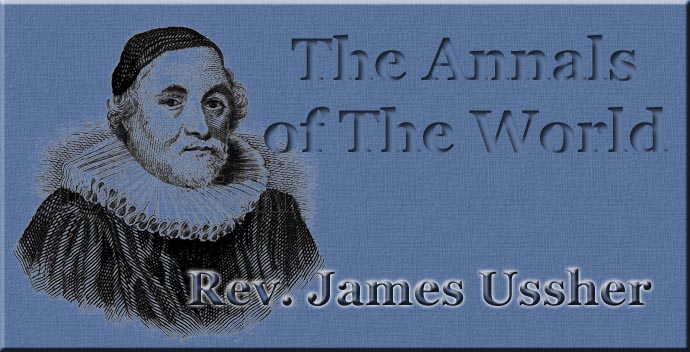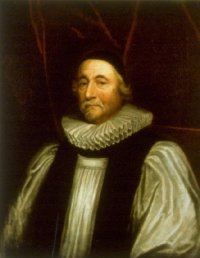
The Annals of The World
Rev. James Ussher
Biography
James Ussher, was one of the greatest scholars and theologians of his time. In his enduring search for knowledge he travelled widely in Britain and Europe, seeking the earliest available manuscripts, buying those he could, and copying others. After his death, his extensive and valuable library, formed the nucleus of the great library of Trinity College, Dublin. James Ussher, archbishop of Armagh, was the pre-eminent figure in the contemporary Church of Ireland, and a leading patron of scholarship at Trinity College, Dublin. A staunch defender of episcopacy, he was nevertheless respected on all sides during the religious upheavals of the 1640s and 1650s, and regarded as the person most likely to achieve an accommodation between the Presbyterians and the Church of England. As such, he was valued by Hartlib and Dury, both of whom helped him at times with his scholarly work and looked to him as a potential patron for their own schemes. Despite his success as a churchman, Ussher is perhaps most famous for having dated the start of the creation to the evening before 23rd October, 4004 B.C. Ussher calculated this timing in his Annals, a work of biblical chronology which he published in Latin in 1650 (Hartlib noted its progress through the press with great interest), and which was translated into English in 1658. The book was the fruit of many years labour; as early as the summer of 1640, Ussher had been reported ‘spend[ing] constantly all the afternoones’ in the Bodleian working at it (Constantine Adams to Hartlib, Hartlib Papers, 15/8/3A–4B). In the Annals, Ussher developed the chronological work of many earlier scholars, in particular Joseph Justus Scaliger (who had pioneered the use of the Julian period in calendrical calculations) to provide a framework for dating the whole Bible historically. He argued that, although scripture itself only tended to take notice of entire years, the Holy Ghost had left clues in the Bible which allowed the critic to establish a precise chronology of its events, through the application to the text of the results of astronomical calculations and its comparison with the dates of pagan history. Ussher’s system had the advantage of preserving several attractive numerical symmetries, for example the ancient Jewish notion, adopted by Christians, that the creation anticipated the birth of the Messiah by 4,000 years, but it was also heavily dependent on classical chronologies and on an interpretation of the calendar which already seemed out-dated to many scholars. Although not wholly original, Ussher’s work was nevertheless influential and became widely accepted, not least because its dates were later incorporated into the margins of some editions of the Authorized Version. However, Ussher’s chronology rested too heavily on the Hebrew text of Old Testament to escape controversy even in his own day. Its findings were attacked by those who were persuaded that the Greek translation of the Old Testament (the Septuagint) or the Samaritan Pentateuch (both of which presented different chronologies from the Hebrew) were more reliable witnesses to the dictation of the Holy Ghost, or that they concurred more closely with the evidence of astronomy and pagan history. Yet, in the opinion of Hartlib, and perhaps of many others, Ussher’s critics were churlish individuals who were unwilling to admit their own debts to his scholarship. Despite such debates, most seventeenth-century readers of the Bible would have agreed with Ussher that it ought, in principle, to have been possible to establish an accurate and detailed biblical chronology. Illustrated opposite is the title-page from the Annals, engraved by Francis Barlow and Richard Gaywood. This shows a number of the crucial figures and episodes from Ussher’s chronology. Adam and Eve are flanked by the figures of Solomon and Nebuchadnezzar, the builder and destroyer of the first Temple, which is also shown both in its glory and after its fall. The engraving also depicts the second Temple, built after Cyrus allowed the return of the Jews to Jerusalem, and its eventual destruction. The figures of Cyrus and of Vespasian (who was Emperor at the time of the destruction of Herod’s Temple, in A.D. 70) flank a depiction of the Last Supper. This copy of the Annals has also been extra-illustrated by the pasting in of a contemporary engraved portrait of Ussher, which shows him holding ‘God’s Word’, the Bible, in his hand. It was executed for the London printseller, Peter Stent, who advertised it for sale in 1653, 1658, 1662, and 1663.
|
|||
 |
 |
||
|
|
|||
-
Site Navigation
 Home
Home What's New
What's New Bible
Bible Photos
Photos Hiking
Hiking E-Books
E-Books Genealogy
Genealogy Profile
Free Plug-ins You May Need
Profile
Free Plug-ins You May Need
 Get
Java
Get
Java.png) Get Flash
Get Flash Get
7-Zip
Get
7-Zip Get Acrobat Reader
Get Acrobat Reader Get
TheWORD
Get
TheWORD
